YOUR ULTIMATE GUIDE
The Definitive Guide To The ECAA Cambridge Exam (2022)
In this definitive ECAA Cambridge guide we will go through all of the information you’ll need to begin preparing for the exam.
Applicants tend to find the Economics admissions assessment difficult because the test is unlike any other test they have taken in the past. The ECAA is a pre-interview assessment required for applicants who wish to study Economics at an undergraduate level at Cambridge University.
We’ll go through the essential test information, the different sections of the ECAA (and how to prepare for them), along with some practice questions to get started.

Please be aware that the ECAA is will no longer be sat by Cambridge Economics Applicants as of 2022. Applicants for Cambridge Economics will now be required to sit the TMUA. You can find out more information on the TMUA in our Definitive TMUA Guide.
ESSENTIAL INFORMATION
HERE’S WHAT YOU NEED TO KNOW
We’ll cover the sections of the test, relevant dates, scoring, Economics applications for different Cambridge university colleges and more.
Let’s dive in.



What is the ECAA?
The ECAA Cambridge (which stands for the Economics Admissions Assessment) was first used by Cambridge University in 2008. It was created to help differentiate the high caliber of students that were applying to study on the Cambridge Economics university course. With so many students getting straight A’s (or 8s and 9s as they are today) at GCSE, and doing similarly well at A-level, Cambridge university needed another criteria to work with. Because of this reason, it is a tough test.
It is a “pre-interview” assessment which means you must have taken it before your interview date. This is not to be confused with an “at-interview” assessment which is taken on the day of your interview. Contrary to what many people say, it can be prepared for.
We aim to go through absolutely everything you need to know about the ECAA in this definitive blog post so read on to become an ECAA pro!
What is the structure of the ECAA?
The test is split into two sections.
Section 1 is all about Mathematics for Economics. It is split into part 1A and part 1B. In total, you have 60 minutes to complete Section 1.
Section 1A tests your Mathematics skills through 20 multiple choice questions. The types of questions you will face will be shown to you further on in this guide so read on for more information. There isn’t a set time allowance for this section as it is completed within the time given to you for all of Section 1.
Section 1B tests Advanced Mathematics and can be quite difficult, especially if your school syllabus hasn’t covered all the topics that Cambridge University can test candidates on. You can see which Maths topics you need to have a firm grasp on later on in this guide.
Section 2 is an essay section. The paper you have to write is based upon a passage of text. Unfortunately, there is no choice of questions so you have to do the one given to you.
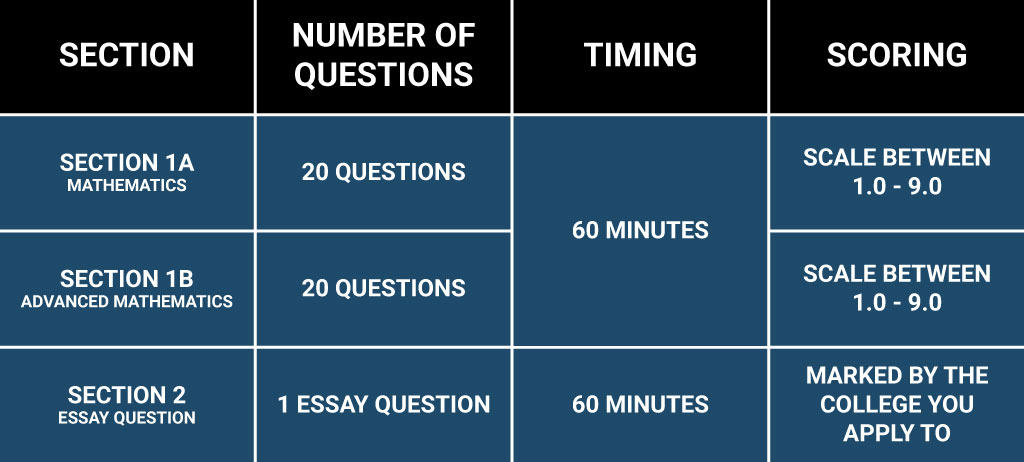

Who needs to take the ECAA?
You formerly needed to book this pre-interview assessment if you are applying to study Economics at Cambridge University at the undergraduate level. Oxford require a different examination, the TSA.
Please note that as of 2022, you will be required to take the TMUA instead. Find out more about it in our Definitive TMUA Guide.
Are there additional requirements to study on the Economics Undergraduate course at Cambridge University?
Candidates applying to Gonville & Caius college must also sit a college set written at-interview assessment. This is a 30-minute mathematics admissions assessment that tests basic maths skills and isn’t designed to be as challenging as the Economics Admissions Assessment.
Lucy Cavendish and Trinity Hall college candidates are required to submit one or two written papers from your college/school as examples of written work before an interview at these colleges.
How difficult is the ECAA?
The economics assessment is designed to be a challenging exam and push candidates to their limit. It is created, unlike normal academic examinations, to draw out a student’s ability to problem solve and use mathematical reasoning – mainly using general maths knowledge.
The test was created to differentiate naturally high performing students applying to Cambridge University. Because of this, it is a difficult test, but one you can definitely prepare for.
What date is the ECAA test taken on?
The test ordinarily takes place in early November each year, usually on a Wednesday morning.
In 2022, the pre-interview exam is due to be taken on the 3rd of November. This is for applicants seeking 2023 entry, who would be due to sit their interview in December 2022.
BOOK BY
OCTOBER
15TH
EXAM DATE
NOVEMBER
3RD
When must I be registered for the ECAA by?
You must book and register by the 15th of October (also the Cambridge university application deadline date) and have completed the test before your interview. Your assessment center must do the booking for you. We would recommend booking well in advance.
Where do I sit the ECAA?
If your school is a registered test center, then you should be able to sit the test at your school. If not, you will have to book and sit the Economics assessment at an authorized test center.


How is the ECAA scored?
The economics assessment is only positively marked, meaning that if you get an answer wrong, there is no downside (apart from not gaining the mark of course). Because of this, applicants should attempt every single question available to them.
Section 1A (Mathematics) and Section 1B (Advanced Maths) are equally weighted. Section 2 is graded based on the argument you make and the clarity of your written work.
How is the ECAA used?
It depends on the college you are applying to as they will place a different weight on different sections of the test. If you are set on a particular college, you should find out what they will be looking for by emailing the college admissions office. For instance, Girton College may look for candidates who scored highly in the maths section, whereas Churchill may have an equal weighting for the maths and essay section. *This is just an example of how colleges may use your score.
It’s also important to note that you are very likely to get an interview at Cambridge University as they interview a high proportion of candidates (over 70%). Therefore, your ECAA score may not be instrumental in getting an interview, but will be a very important factor in the final decision made on your application.
Exams.Ninja General Tips For ECAA
Start preparation EARLY
It’s much easier to prepare for the Economics Admissions Assessment by starting earlier and breaking it down into smaller chunks. Spreading out your learning over time gives your brain time to assemble the information, especially with regards to the Maths sections, as the problem types are often repeated. This is called “spaced repetition” – it is a well-established concept that has been proven to embed memories more deeply in your mind. And it gives you a less stressful preparation period, so what’s not to like?
Prioritize effectively
The clock is your biggest enemy in the test, especially in Section 1 (particularly the Maths Section 1B). If you spend too much time on one problem, you will be giving yourself less time for the problems you still have left. Each and every correct answer in this section carries the same weighting, no matter whether they are in Section 1A or Section 1B, so there is no point in getting bogged down over one difficult multi-part question when you could gain the same number of marks (or most likely, more) by simply skipping it and moving on.
Practice makes perfect
This goes without saying, but if you can spend more time practicing, the better off you’ll be. We’d always recommend focusing on the areas you find most difficult (time permitting) so if you are getting stuck on maths questions, revise the syllabus and work on those.
By familiarizing yourself with the question types, you’ll be able to spot patterns and get more confident with the assessment. It’s important that you practice under exam conditions – mainly in reference to timing as this can be killer!
THE PROBLEM SOLVING SECTION
ECAA SECTION 1A
Section 1 gives you 60 minutes to answer 40 questions. This gives you just over 2 minutes each, so if you find yourself stuck on a problem for longer than 2 minutes, skip it and move on! The students who tend to drop the most marks in Section 1 are the ones who try too hard to answer difficult questions and waste the little time they have.
This part forces you to think differently to how you may have for A-level and GCSE. A-level examinations tend to be much more academic than the problems presented to you in this test.
As we mentioned earlier, Section 1 is split into Section 1A (Mathematics) and Section 1B (Advanced Maths). We’ll cover Section 1A first.



Section 1A Mathematics Questions
There are several types of questions you can come across in the Economics assessment.
All of the questions in this section are based on assumed Mathematical knowledge; compared to Section 1B, it’s not terribly difficult to prepare for.
Section 1A Mathematics Questions
Maths questions in the ECAA have many variations and can be quite difficult (spotting a pattern here?), even though the content isn’t hugely advanced. This is because they are likely to be different to what you have encountered at A-level. We recommend applicants get to grips with these simply by doing a lot of practice papers on this area.
A few key tips you should consider when doing data analysis are:
- Reading the options first.
If you read the options first, you always know the ballpark or depth of working required to get the answer. It’ll also signpost the key information to look out for in a problem before you read it.
- Working with numbers.
This may seem like basic maths but it’s a vital time-saving strategy you can employ to perform better in this section. For example, percentages come up frequently. You should become accustomed to working out increase or decreases in more complex percentages such as 22.5%. A good way to do this is to break them down into manageable figures i.e. 20% and 2.5%.
- Graphs and tables.
Whenever you come across a graph or a table, you should look at the information in the following order;
- Read any instructions.
- Look at the headings or axis.
- Look at the units.
- Finally, look at the data presented.
By reading a graph this way, you’ll understand the information provided more quickly than any other method.
THE ADVANCED MATHEMATICS SECTION
ECAA SECTION 1B
Section 1B of the Economics assessment focuses entirely on Advanced Maths.
You have 60 minutes (including Section 1A) to answer 20 maths problems. Although you have more time per question in Section 1B, the problems tend to be more difficult and thus, take more time.



Section 1B Maths Required Knowledge
The required knowledge for the ECAA Cambridge is quite broad. Unlike Section 1A, we’d strongly recommend that you get up to speed with each of these topics before attempting any practice papers.
That being said… here’s a practice question for you to have a go at.
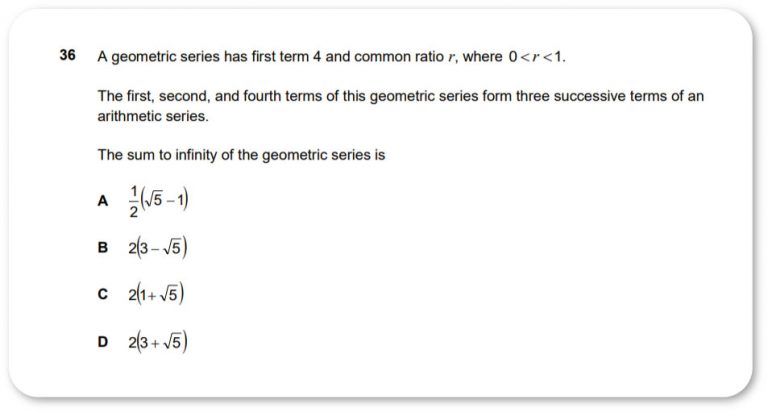

This is the required knowledge that you should absolutely be aware of when doing this part of the examination.
You may have covered some topics through A-level maths but you should ensure you are satisfied with all of the topics before diving in. Here they are:
- Laws of Indices
- Manipulation of Surds
- Quadratic Functions: Graphs, use of discriminant, completing the square
- Solving Simultaneous Equations via Substitution
- Solving Linear and Quadratic Inequalities
- Manipulation of polynomials e.g. expanding brackets, factorising
- Use of Factor Theorem + Remainder Theorem
- Sketching of common functions including lines, quadratics, cubics, trigonometric functions,
logarithmic functions and exponential functions - Manipulation of functions using simple transformations
- Graph of series y=ax
- Graph of y = ax series
- Law of logarithms:
- ab = c <-> b = logac
- logax + logay = loga(xy)
- logax – logay = loga(x/y)
- k logax = loga(xk)
- loga 1/x = – logax
- logaa = 1
- First order and second order derivatives
- Familiarity with notation
- Differentiation of functions like y=xn
- Definite and indefinite integrals for y=xn
- Solving Differential Equations in the form: dy/dx=f(x)
- Understanding of the Fundamental Theorem of Calculus and its application
- Terminology: True, flase, and, or not, necessary, sufficient, for all, for some, there exists.
- Arguments in the format:
o If A then B
o A if B
o A only if B
o A if and only if B
- Equations for a circle
- Equations for a straight line
- Circle Properties
- Arithmetic series and Geometric Series
- Summing to a finite and infinite geometric series
- Binomial Expansions
- Factorials
- Solution of trigonometric identities
- Values of sin, cost, tan for 0, 30, 45, 60 and 90 degrees
- Sine, Cosine, Tangent graphs, symmetries, perioditicties
There are also several formulas you must know before starting practicing ECAA Section 1B. Again, you may have covered some at A-level. Focus on the ones that you are not familiar with.
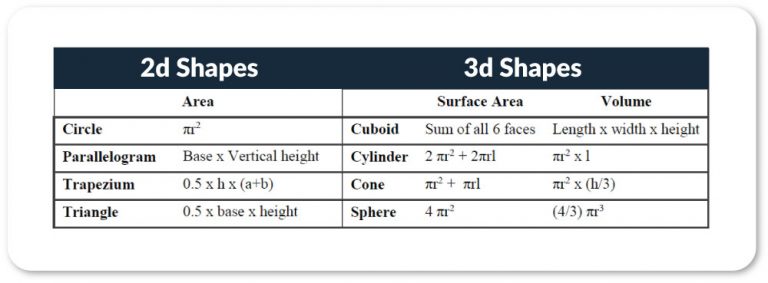

OTHER FORMULAS YOU NEED TO BE FAMILIAR WITH
Completing the square
Quadratic formula
Difference between two squares
Here’s the answer to the question we had above. Did you get it right?
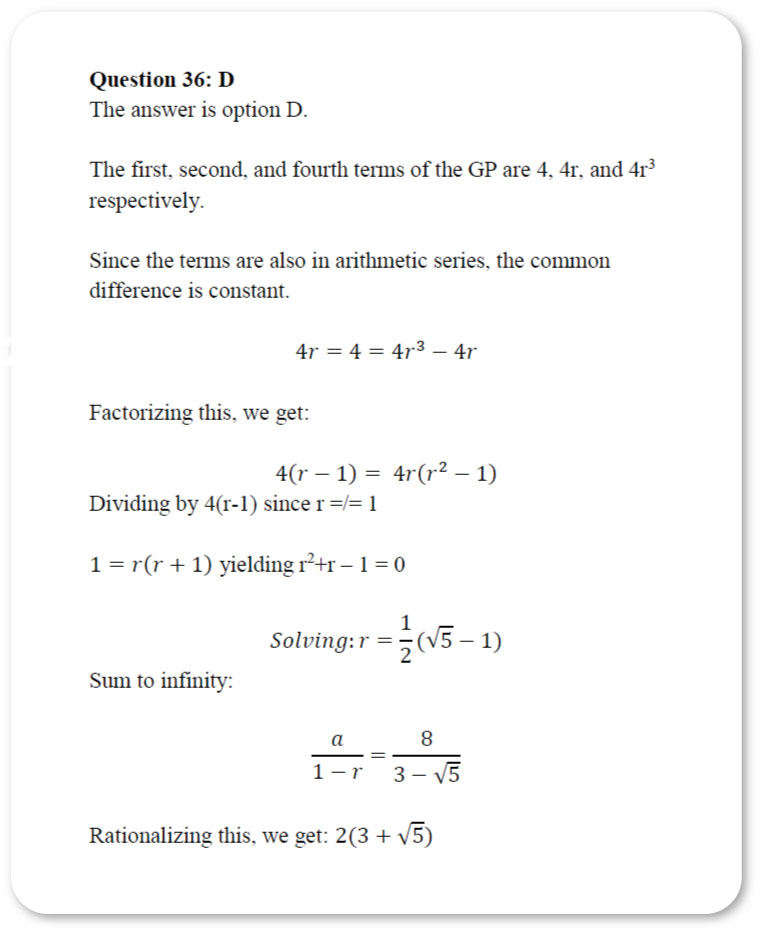

THE ESSAY SECTION
ECAA SECTION 2
Unlike many university admissions tests, the ECAA Cambridge test does not give you a choice of questions to answer which forces you to do the one they present. Although this does offer you less flexibility, the same bodes true for every other candidate as well. This section exists to test your comprehension skills and ability to construct a strong argument, whilst conveying this effectively to the reader. You have 60 minutes to write the entire paper.
This is the section you stand to gain the most marks from if you don’t have much time to prepare. You have a very limited space (one A4 page) to write your essay, so you must write concisely.



Section 2 Structure
The ECAA essay structure is no different to other papers you will have written in school at A-level. The basic structure is Introduction -> Main Body -> Conclusion. Here’s a breakdown of each section.
INTRODUCTION
This should be the shortest section by far. It serves to provide a transition into the main body whilst providing some context (but not repeating the statement/problem!). You can think of this as a snapshot of what is to come without giving it all away to the university admissions tutor.
MAIN BODY
This is where you bring in your arguments for and against. Each major point should be made in a separate paragraph and structured in a logical way (as should your entire paper). The paragraphs should lead into one another smoothly. University examiners are looking for an applicant who can effectively demonstrate their understanding of a topic, along with providing a balanced view and keeping the initial question in mind the entire time.
As there isn’t a great deal of space, we’d recommend covering no more than 3 arguments in the main body. You should link supporting evidence throughout the essay with examples wherever possible.
CONCLUSION
The conclusion is usually the part remembered by the university’s economics admissions tutor who is marking your work. You should make a firm, grounded conclusion that stems from the points you’ve brought up in the main body. Occasionally, you can use the conclusion to introduce a new idea that you haven’t explored in the essay prior, however, this can get the reader second guessing about the points you’ve already made.
Planning Your Writing
By far the most effective way to approach the ECAA Section 2 essay is to start by planning. Many students go in all guns blazing and start writing before they have a clear idea of what they want to say and how they want to say it – this is a school boy error. Oftentimes, you’ll begin writing and uncover a new point which is stronger than an argument you’re currently writing about.
As you have 60 minutes to work with, you should spend the first 5-10 minutes planning what you’re going to say. It may feel like wasted time, but you’ll find that once you have a plan, you’ll be writing quicker anyway. Most importantly, you will have a much better focus on the question you are trying to answer by planning first.
You can plan however you prefer. Many candidates tend to go with mind maps or bullet points so get their thoughts down on paper. By using a mind map, you can see a natural flow of ideas and begin planning the structure of the essay. Think back to however you revised for A-levels and GCSEs at school – if there was a technique that worked best for you then, it’ll likely work best for you now.
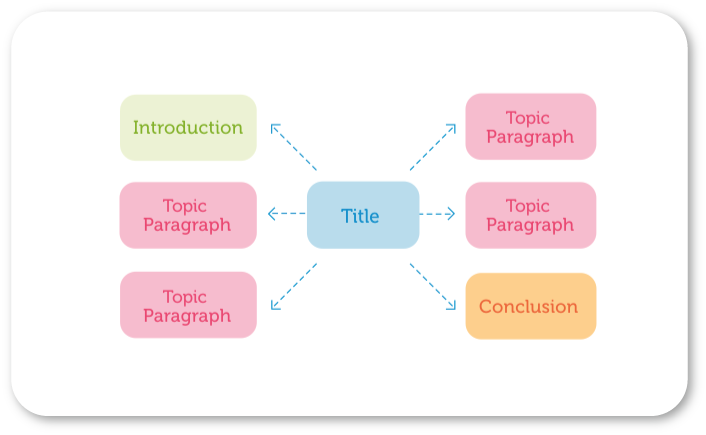

Before you begin writing, you should have an idea of what your conclusion will end up being.
COMMON MISTAKES YOU MUST AVOID
Only considering one side of the argument
A big mistake we commonly see applicants make is writing a completely polarized argument that doesn’t consider the other viewpoint, which university admissions tutors will pick up on quickly. There are always two sides to a story and you must consider both when writing an effective ECAA essay.
Not defining terms
Another is not defining terms that could be misconstrued. For example, if you present the question: “Do dogs make the world a better place?”
“Better” could be understood as making the people around them happier and providing humans with a sense of enjoyment. However, it could also be understood as contributing to the betterment of the world. However much you may like dogs, it can’t be argued that they “better” the world in that respect. Make sure you define terms so that the examiner has no choice but to understand your viewpoint.
Missing the point
Although there are many more common problems, the most common is a simple one. Students who simply miss the point. This could be by not answering the question in full, or not understanding what was asked of them. You need to work out the “hinge” of the question before you start writing and state it clearly (even just to yourself) so that you cannot miss the point.
Wrapping it all up
The ECAA has been replaced with the TMUA for all Cambridge Economics Applicants. However, many of the tips you’ll have learnt from this guide will help you through the TMUA, as they not as different as you may initially think.
If you want more information about the TMUA, check out our Definitive TMUA Guide.
The ECAA will no longer be taken, but you can still prepare for the TMUA with Exams.Ninja!
With our TMUA Preparation Platform, you’ll be able to get ahead of your preparation with our amazing revision tools. Get access to tons of resources, including:
Training Temple- exclusive tips, essay guides and tons of expert tutorials to shape your exam skills.
Practice Dojo- over 500 questions covering the whole of the TMUA. You’ll get a fully explained answer for each so you’ll know what to do for the real thing.
Exam Arena- Try out 5 complete Past Papers in a simulated exam environment. Each try will be fully marked using the real grading scheme.
Start your TMUA preparation today and maximise your chances of success.

